A Look at the Latest in Optics
Optics is the study of the origin and propagation of light, how it changes, what effects it produces as it interacts with matter, its various phenomena, and the instruments used to study it. Optics includes the study of sight—how we see. All light is electromagnetic radiation, some visible to the human eye, and some invisible (for example, infrared light).
The history of optics stretches all the way back to the ancient Egyptians and Mesopotamians, who developed the earliest lenses. The theories and science of optics were advanced by Greco-Roman philosophers and scientists, furthered by Islamic study during the middle ages, and advanced rapidly in Early Modern Europe, particularly through the work of Johannes Kepler in the early 17th century.1
In the 20th and 21st centuries, the science of optics has come to incorporate wave optics and quantum optics. From lasers and holograms to electron microscopes and contact lenses, some of the most significant technologies in everyday use have been made possible by aspects of optical science. New research and breakthroughs continue to advance knowledge and expand the applications of optics; this blog takes a look at some of those breakthroughs.
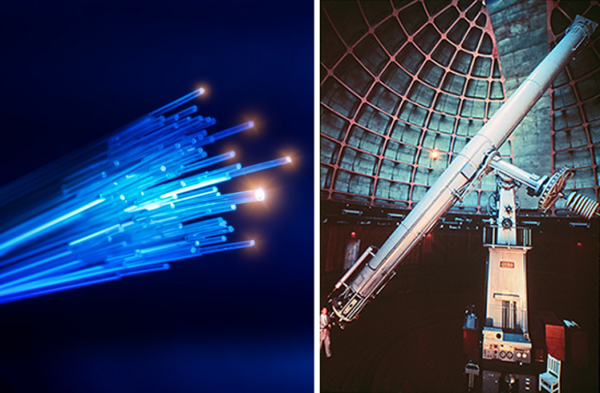
Optics applications include telecommunication fiber optics cables (left), and the 36-inch refracting telescope of Lick Observatory in Mt. Hamilton, California (right). (Image: Source)
The Optical Frequency Comb
One of the most significant breakthroughs in optics in recent decades is the “frequency comb,” a form of laser-based spectroscopy that can determine the color of light atoms and molecules with extreme precision.2 Made possible by the development of ultra-fast lasers, optical frequency combs rely on the relationship between time and frequency: the number of oscillations per unit of time.
Originally developed to enhance the precision of atomic clocks, frequency combs have become a common tool for detecting and measuring different frequencies of light with extreme precision. “Unlike conventional lasers, which emit a single frequency, these lasers emit multiple frequencies in lockstep, evenly spaced to resemble the teeth of a comb. Today, they are used in everything from environmental monitoring and chemical sensing to the search for exoplanets, optical communications, and high- precision metrology and timing.”3
The National Institute of Standards and Technology (NIST) explains how optical frequency combs are generated: “NIST scientists start with lasers that emit a continuous train of very brief, closely spaced pulses of light containing a million different colors. The properties of the light over time are converted to frequency numbers to make what looks like a comb. Time and frequency are inversely related; that is, smaller units of time (or faster oscillations of light waves) result in larger frequency numbers.”4
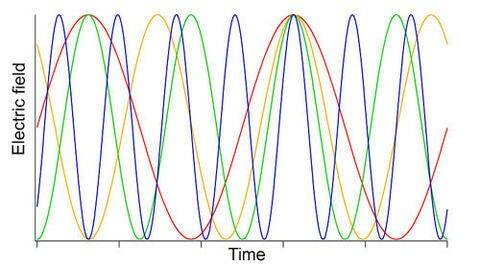
This image is greatly simplified to show how different colors of light oscillate over time, demonstrating that the blue waves oscillate fastest and red waves oscillate slowest (units/specifics are unimportant, in reality units would be tiny fractions of seconds). (Image source: NIST)

This image (also greatly simplified) shows the frequency comb corresponding to the graph above. “Each ‘tooth’ of the comb is a different color, arranged according to how fast the light wave oscillates in time. The waves that oscillate slowly (red) are on the left and the waves that oscillate faster (blue) are on the right. Frequency is measured in hertz, or cycles per second. An actual optical comb does not begin at zero on left, but at a very high number, 300 trillion hertz.”5 (Image source: NIST)
NIST further explains: “A real optical frequency comb spans the entire visible spectrum of light, and has very fine, evenly spaced teeth. The teeth can be used like a ruler to measure the light emitted by lasers, atoms, stars, or other objects with extraordinarily high precision.”6
The Nobel Prize in Physics 2005 was awarded in part to John L. Hall and Theodor W. Hänsch "for their contributions to the development of laser-based precision spectroscopy, including the optical frequency comb technique."7 Today, the technique is used for applications such as environmental monitoring and chemical sensing to the search for exoplanets, optical communications, and high- precision metrology and timing.
Just this month, the latest breakthrough in optical frequency combs was made by researchers at Harvard’s John Paulsen School of Engineering— harnessing turbulence in light waves. These researchers were able to transmit wireless signals from laser frequency combs to create the first laser radio transmitter. This discovery has potential applications in telecommunications and portable sensing, microresonators, optical spectroscopy, and chemical sensing. Learn more...
Additional Recent Breakthroughs in Optics
Seeing Around Corners
A team from Princeton University’s School of Engineering has developed a radar that can see around corners, which can be easily integrated into today’s automobiles to increase vehicle safety and avoid collisions. The system uses Doppler radar—already common for tracking fastballs in baseball—to bounce radio waves off surfaces such as buildings and parked cars.
The radar signal is reflected from these stationary objects and rebounds at an angle, next striking objects that are hidden around a corner. Some return signal then bounces back to receptors on the car. The system uses this information to see objects around corners and determine if they are stationary (such as stopped traffic) or in motion (such as a walking pedestrian). Learn more…
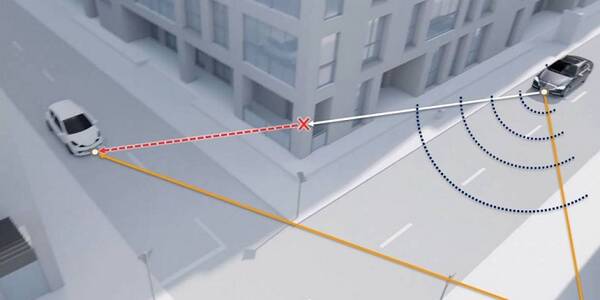
An illustration of Princeton's new radar detection system that can "see" around corners. (Image ©Princeton University, Source)
Doing Cartwheels
A novel type of polarized light has been discovered by researchers at Rice University that does “cartwheels”—turning end over end as it propagates from a source. The effect, called trochoidal dichroism, is a previously unknown interaction between polarized light and matter. This type of “freely propagating circularly polarized light interactions” are important to several technology applications, including types of 3D glasses that discriminate between opposite light polarizations. Learn more…
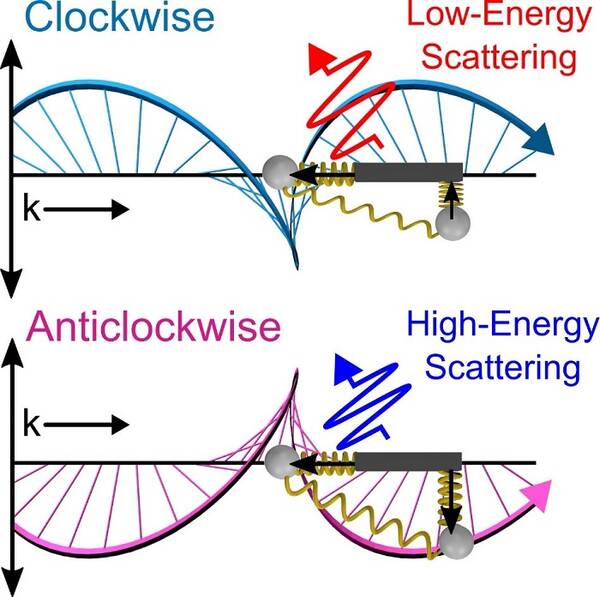
"A model by Rice University scientists shows how two positively charged spheres attached to springs are attracted to the electric field of light. Due to the motion of the spheres, the spring system scatters light at different energies when irradiated with clockwise and anticlockwise trochoidal waves.” Credit: Link Research Group/Rice University (Image Source).
Counting Photons
Researchers in Switzerland have developed a new camera that can detect single photons of light traveling at high speed. This capability will help advance applications such as augmented reality and LiDAR systems that rely on quickly acquiring 3D images for real-time processing. The megapixel photon-counting camera is based on next-generation image sensor technology that uses single-photon avalanche diodes (SPADs). Learn more…
Measuring Light & Color
If you have a need to measure the visible or near-infrared (NIR) spectrum of light and color, Radiant’s ProMetric® Imaging Photometers and Colorimeters provide high-resolution, low-noise measurement for a wide range of optical metrology applications. By matching the human eye’s sensitivity to light, our imaging systems enable manufacturers of displays and lighting products to measure spatial values for luminance, chromaticity, radiant intensity, and more. We’ve been helping companies advance optical applications in the lighting and displays in the R&D lab and on the production line for more than 25 years and have solutions for a range of applications.
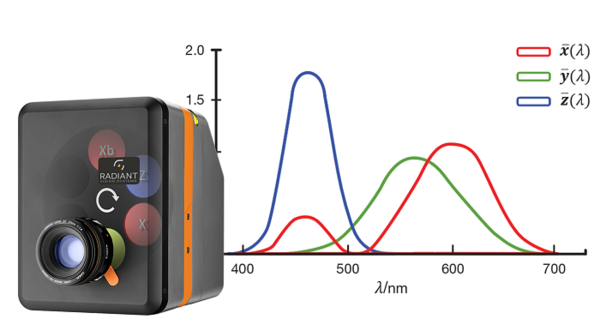
Scientific-grade ProMetric imaging systems from Radiant measure and evaluate light in a way that simulates human photopic response, based on color-matching functions described by the CIE technical report, CIE 015:2018 Colorimetry.8
CITATIONS
- Thompson, B. and Kingslake, R., “Optics”, Encyclopaedia Britannica. (Retrieved June 22, 2020).
- “Laser-based precision spectroscopy and optical frequency comb techniques.” in Advanced information on the Nobel Prize in Physics 2005, The Royal Swedish Academy of Sciences, October 4, 2005
- Piccardo, M., Schwarz, B., et al. “Frequency combs induced by phase turbulence.” Nature, 2020; 582 (7812): 360 DOI: 10.1038/s41586-020-2386-6
- Optical Frequency Combs, NIST. (Retrieved July 2, 2020)
- Ibid.
- Ibid.
- “Laser-based precision spectroscopy and optical frequency comb techniques.” in Advanced information on the Nobel Prize in Physics 2005, The Royal Swedish Academy of Sciences, October 4, 2005
- Carter, E., et al., Eds. CIE 015:2018 Colorimetry, 4th Edition. doi: 10.25039/tr.015.2018
Join Mailing List
Stay up to date on our latest products, blog content, and events.
Join our Mailing List
